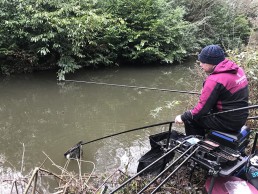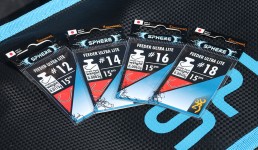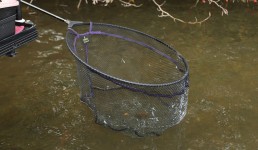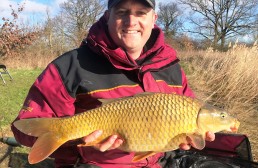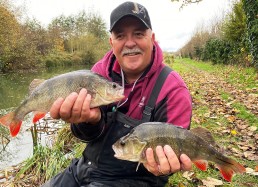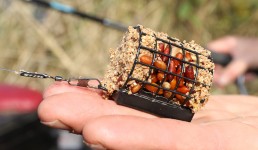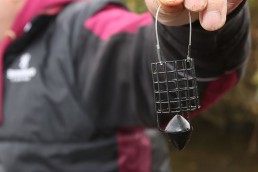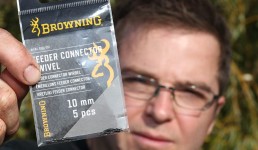Bread Punch for Canal Roach
First Published in English.
If there’s one place where you can find some respite from this winters atrocious weather and get some action then it on a canal. I love canal fishing and today I’ve come to one of my favourites, the Basingstoke Canal just outside Aldershot in Hampshire, for a few hours in the hope of some roach on bread punch. Just to enforce just how much rain we’ve had recently it’s the first time I’ve ever seen a steady flow on this canal, it’s also carrying some colour which is amazing as two weeks ago it was gin clear! It’s far from perfect punch conditions, that’s why it’s always important to bring at least one back-up bait such as maggots or worms as it’s so easy to get caught out at times.
Kick-starting the swim
The swim I’ve chosen is in a known silver fish area and a few weeks back a match was won with nearly twenty pound of skimmers and roach, yet conditions have dramatically changed so although I’m confident of a few fish, I’m not quite sure just how it will fish. I’m going to feed three lines, one down the middle to my left in the main boat channel and two to the far bank cover. The line down the middle is going to be my first punch spot and I’m going to kick start this with a couple of small balls of fine liquidized bread squeezed around a stone in order to get it down to the bottom quickly. One of my far bank lines, slightly left of centre, is also a punch line and is fed in the same way, with the other far bank line to my right fed with a couple of balls of Champions Choice Black Magic groundbait and a few maggots just in case the punch doesn’t work.
Bait preparation
There are quite a few ways to prepare bread for punch fishing but when fishing a canal for silvers I want to toughen up each slice slightly so it’s doesn’t simply fall of at the slightest movement or every time I lift into a bite. I always use medium slice white, something like Hovis is ideal, then remove the crust, place each slice in a microwave for 20 seconds before compressing using a rolling pin. Each slice is then cut in half and once I have around 12 half slices I place them all into a plastic bag and into the fridge overnight. When I’m on the bank, just one half slice at a time is removed, placed on a flat, hard surface before punching using a metal headed punch as and when I need them. The ideal punch size for canal fishing is between 3mm and 5mm. To prepare the perfect liquidised bread feed is simple, just remove all the crusts and liquidize the remaining slices in a blender. A little tip for producing really fine crumb is freeze the liquidised bread, then remove and whilst still frozen blitz in a blender again. The more you freeze and blend the finer your liquidized feed with be.
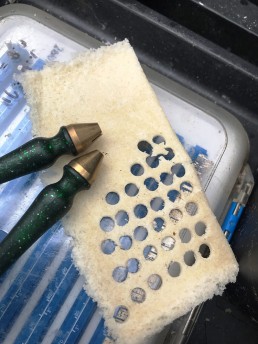
Metal punches cut through the bread cleanly.
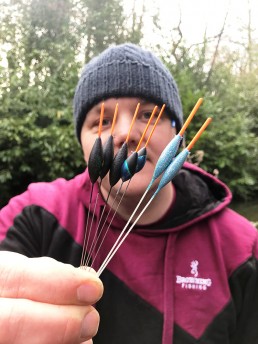
Slim bodied delicate floats are best for punch fishing on canals.

Sphere Feeder Ultra Lite hooks, brilliant.

Microbore Elastic, thin, smooth, reliable and long lasting.
"In just a couple of hours I have caught over 50 roach."
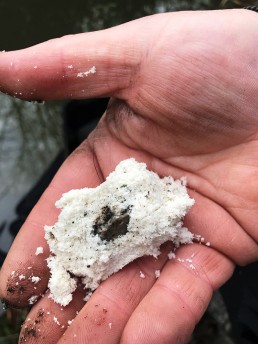
A small stone in the middle will get the feed down quickly.

Use a pole cup for accurate baiting.
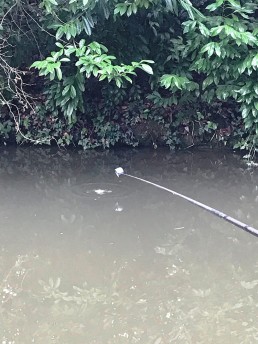
A couple of balls at the start should get them going.
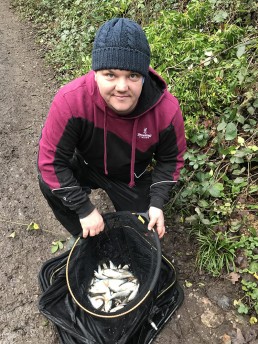
I’m really pleased with the mornings catch.
Delicate rigs
I’m fishing the pole at approximately 12m to the far bank and for my punch fishing I’ve made two rigs up which are almost identical apart from the depth they are fishing. The reason for this is I’m going to be switching these continuously and don’t want to waste time having to plumb up every time I change position. The rigs are created using Cenex 0.13mm Fluoro Carbon Hook Line with a 0.11mm bottom. Float choice is important and need to be more of a delicate slim bodied shape as bites can be very finicky. For the far bank line I’m using a 4xNo10 and down the middle a 4xNo12 along with Sphere Feeder Ultra Lite micro barbed size 18 hooks attached, perfect for punch fishing. Both floats are shotted using a string of tiny shot, six inches from the hook and all positioned slightly apart. I’ve decided to fish an inch over depth from the off and if the roach are feeding aggressively then I will come up in the water.
No consistency
I arrived just before first light, a great time for a practice session on a canal as the banks are quiet and the fish seem to feed with more confidence. First drop in on the middle line and the float disappears, the culprit a roach. Another half a dozen come to hand before the line is shattered by a jack pike, a common occurrence here and another reason to feed and fish more than one line. A switch to the far bank once again produces a few small roach before going quiet, pike maybe, so I try the maggot line which again produces a few tiny roach before dying. I don’t think the reason each line produces a few then goes quite is due to predators as this section is very shallow, only two and half feet at best and I’m sure I would see some disturbance or even have a roach attacked whist shipping in, so I just think it’s a pattern where a few fish are caught before spooking. This pattern continues on the punch lines, yet on the maggot line bites completely dry up so I decide to feed another punch line, before rotating these which seems to keep the fish coming. Amazingly last week lots of skimmers showed here, great match weight makers, yet today all I can catch are roach, the best around 10oz and a few small perch. Obviously the massive change in conditions has seen the bream move on, shame.
Knowledge gained
Its mid morning now and being a weekend the tow path is becoming increasingly busy, probably the reason that the bites have slowed up considerably, however with getting on for fifty roach and a little more knowledge on just how the canal fish’s in these conditions will certainly put me in a good position for the friendly teams of four matches that will be fished here in the coming weeks.
Jamie’s Tackle
0.13mm and 0.11mm Cenex Fluoro Carbon Hook Line
Sphere size 18 micro barbed Feeder Ultra Lite Hooks
1.3mm Lime Green Xitan Microbore Elastic
4×10 & 4×12 slim line pole floats
Jamie’s Bait
Medium sliced bread, punched and liquidised
Champion’s Choice Black Magic Groundbait, maggots and worms as back-up
Sphere Feeder Ultra Lite Hooks
First Published in English
A lot of my feeder fishing on natural venues revolves around catching numbers of silverfish averaging a few ounces each, but of course the chance of a rogue lump or two as well. Hooks and hooklengths need to be relatively refined for this style of fishing, but not so light that the ever-present chance of hooking a decent bream, eel or tench is ignored or worse still wasted when light gear loses the battle. Whilst they cannot be relied upon, those bonus fish can mean the difference between winning and losing, so I need to capitalise on every opportunity.
Light hooks are great for presentation, and ensure my hookbait looks as natural as the particles it’s surrounded by, but of course everything on a feeder tends to require stepping up a bit. My hook of choice for this style of fishing is the Sphere Feeder Ultra Lite, which despite being exceedingly light weight, packs an amazing amount of strength – don’t be fooled by the larger sizes, these area great for bit baits and aggressive retrieves when you need to ensure fish stay on all the way back. This must be down to the Japanese wire and tempering process used, but also the shape too. Whatever the ‘secret alchemy’ used, they have proven to be extremely reliable for this style of fishing.
Another point (sic) worth mentioning are the points! These really are razor sharp, but last really well too, meaning I bump less fish and need to change my hooklength less often.
Hook shapes are a very personal thing, but I do like the slightly ‘wedge-shaped’ bend on these hooks that see the point facing very slightly towards the shank. This shape, combined with the straight point, goes in and stays in, meaning less lost fish when I am fishing at range.
Bait wise, this is an allrounder, but really is a great maggot hook, especially when fishing with two or three grubs. It also lends itself really well to fishing worm heads and bunches of caster too. A great feeder hook that I use a lot.
Available in sizes 8 to 18
Kye Jerrom
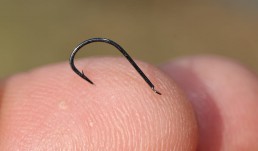
This is an exceptionally sharp hook that keeps its point really well.
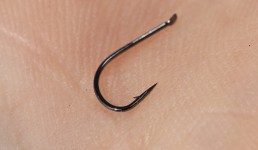
The shape is perfect for maggots, casters and chopped worm.

This is a brilliant hooks when lots of fish are on the cards.
"A brilliant hook for maggot fishing."
CK Competition Landing Net
First Published in English.
When bream and other larger fish are the target you need a net that is not only robust, but easy to manoeuvre. The CK Competition net meets these requirements admirably, and is available in several versions to meet different types of fishing.
I tend to use the medium size which at 50cm by 40cm is just right for bigger fish. The depth is just right too, being not too deep, making it easy to unhook fish with the net held firmly between my knees.
The mesh on the large net has an 8mm diameter, making it very easy to push through the water. It is also really soft and the fish do tend to lay quietly in it. I have also found that the mesh is quite hook-resistant too, which can save time.
The metal frame is really strong and is securely fixed into the spreader block. All in all, this is a very well thought out net that does exactly what it is designed to do with the minimum of fuss.
Small – 45cm x 35cm frame by 28cm deep, with 8 x 8mm mesh
Medium – 50cm x 40cm frame by 28cm deep, with 8 x 8mm mesh
Hair Mesh – 50cm x 40cm frame by 28cm deep, with 2 x 2mm mesh
Pat Cuddy
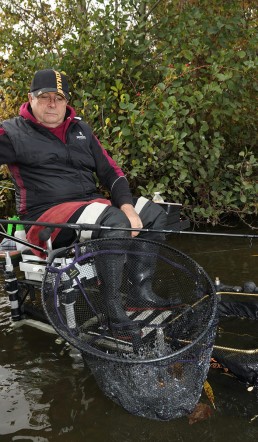
The 8mm mesh makes the net very easy to move through the water.
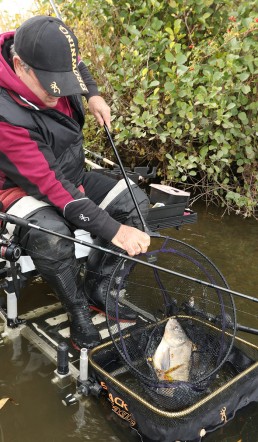
The ideal net for larger fish, such as bream and carp.
"The size and depth are just right."
Catch Carp on Bread Disks
First Published in English.
Location, location, location
The most important factor in consistently catching in the depth of winter is location and my advice at this time of year is to head to a lake you know well and then, if possible, drop into the ‘banker’ swim. You’ve probably heard it a thousand times before, but if you haven’t got fish in front of you, it doesn’t matter if your tackle and bait is the best money can buy, or if you are the best angler in the country, you simply won’t catch.
Today I’m at Brookhall Lake controlled by Colchester Angling Preservation Society, a water I’ve fished for years and it is one of those cruel winters day when there’s been a hard frost, skies and cloudless and to make things worse, a howling chilly wind is blowing. This lake, apart from marginal rushes is relatively featureless to the eye, apart from a set of rushes at the far end of the lake that are situated in open water. Nine times out of ten it contains fish so with no other anglers around, guess where I’m heading? This swim gives me options, open water, reeds on the far bank but most importantly the rushes and this is exactly where I’m going to investigate first.
You can’t beat bread
Bait for the day is simply bread, a bait that seems to be overlooked these days, especially when the tackle shops shelves are full of bright coloured boilies and pellets to choose from, but believe me, bread will catch when all else fails so don’t forget it. Something else worth considering is where the carp are going to be, and take it from me they are rarely if ever laying on the bottom, but more likely to be sat up in the water, in an area that’s slightly warmer, so a popped up bait is a very good option. Air pressure effects at what depth the carp will be but a rule of thumb is the colder it is the lower down they will be. Although it’s raw today, we have had some very unseasonably mild weather recently so I’m guessing that the water won’t be too cold and that the fish will be well off bottom, so I’m going to pop my bait up thirty inches to start with. I do this simply by hair-rigging a punched 8mm disc, taken from the crust, and sandwich this between two discs punched straight from the slice. The hair needs to be quite long as these discs will take on water and fluff up, so don’t go too short. The best way to hair rig these is to use a Push Stop which is tied to the end of the hair, then with a needle inserted pushed through the discs, before twisting and locking the bait on. Push Stops are also great for hair rigging boilies, corn, even worms, so make sure you have some as they are absolutely brilliant.
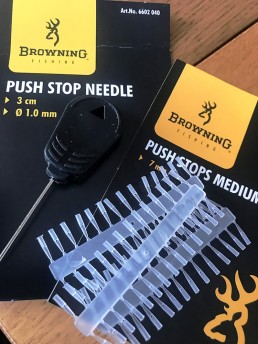
Push stops anchors discs securely on a hair.
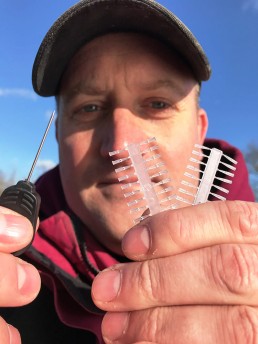
Don’t be without these this winter.
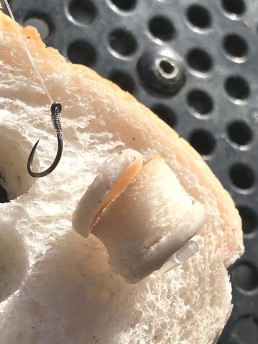
A long hair is essential as the discs will swell up.

The bread swells up in water, filling the hair.
"All you need are a few slices of bread"
Balanced kit equals complete faith
As for the rig, I’m using what’s known as an inline safe system, simply because it gives me the flexibility to change the length of the hooklink, which needs to be done regularly to find where the fish are, or if needed, the size of lead, yet a small semi-fixed inline lead will do the job. As for rod, reel and mainline you have to have complete faith in these, as when fishing close to a feature you need to pile the pressure on instantly and steer the fish into open water. My kit consists of an 11’ CK Method Feeder Rod with the 1oz tip added. This rod has plenty of power in the middle reaches yet the soft tip avoids hook pulls under the rod tip. The reason for using the 1oz tip is it allows me to tighten up to the lead without pulling the rig out of position. This slight tension means that the majority of bites are dropbacks, where the fish has picked the bait up and dislodged the lead, before seeing the tip pull round as the carp bolts. My reel is an 845 Black Viper Compact loaded with either 6lb or 8lb Black Magic Gold Mono depending on the angling situation. As for hook length it’s the ever reliable Cenex Hybrid Power Mono in a 0.18 diameter which has a Sphere CPF LS Barbless Hook tied knotless knot style to produce the hair.
Have a cast around
In the winter, when it’s really cold I don’t put any loose feed in, but simply rely on this visual bait wafting around in the water to gain some interest. Today I’ve started by casting the rig around a rod length off the side of the rushes, as there is no need to go really tight unless you have to. Unfortunately after forty minutes very little has happened, even though I’ve been casting closer and closer to the rushes, however at last, a cast really close has finally produced a bite from a carp around 8lb. I find that it’s worth casting around at first, as often the carp aren’t right in the feature and that a small lead is best as it doesn’t cause too much disturbance. Quite often a bite will come quickly, in the first minute, but if not then you might have to wait up to ten minutes, but once this period is up, it’s time for a recast, slightly further out, or tighter to the feature. Once a carp is caught it’s a good idea to target this spot, yet if things don’t happen, start casting around again to find them. Today the carp are obviously shoaled tight within the rushes, probably due to this cold wind as all my bites have come right up close to the rush stems. Sometimes you just have to go to them, and that’s exactly what I’ve had to do today.
Tim Bruce – Wickford Browning

Vary the hooklength to fish at different depths.

Cast around the swim until you find the fish.
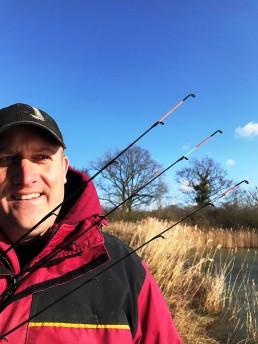
Use a reasonably soft tip as the bites can be quite subtle.

One of many to warm me up on a cold morning.
Tim’s Tackle
CK 11ft Method Feeder
Black Viper 845 Compact Reel
6lb Black Magic Gold Mono
0.18mm Cenex Hybrid Power Mono
Size 14 Sphere CPF LS Barbless Hook
7mm Push Stops and Needle
8mm Bread Punch
2/3rd ounce inline safe system lead
Tim’s Bait
Warburton’s medium sliced toast white bread.
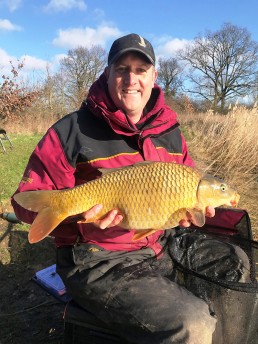
A lovely golden carp brightens up a cold winters day.
Sphere Match Hooks
First Published in English.
My local river Trent offers has some brilliant fishing on offer and one of my favourite tactics is to fish for the abundant roach, dace, and small chub on the pole. This is often bite-a-chuck fishing, swinging good fish to hand, so any chinks in your gear will soon be found out.
My hook choice for this style of fishing is the Sphere Match, normally in a size 16 or 18. These hooks have just the right wire gauge for maggot and caster fishing, being incredibly light, but very strong.
They also keep their points very well and are razor sharp. I can often go all day using the same hook, which saves a lot of time during a match. The slightly in-turned point also goes in and stays in, meaning very few fish manage to come off as I swing them in.
The shape is interesting, especially for maggot fishing, The tear drop shaped bend makes them brilliant for maggot fishing. The bait sits on the bend, staying put and not getting moved around when you miss a bite, meaning that I have the confidence to let the rig run through if I miss a bite.
A great hook for pole or running line fishing for silvers, but with plenty of strength should you hook a bonus chub or big perch. The Sphere Match hook has quickly become a favourite and has more than earned it place in my box.
Available in sizes 8 to 18, either in packs of 15 loose hooks or pre-tied in packs of 8.
Tom Noton
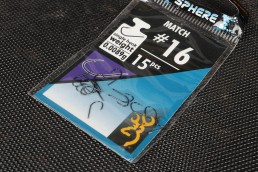
My choice for maggot and caster fishing.
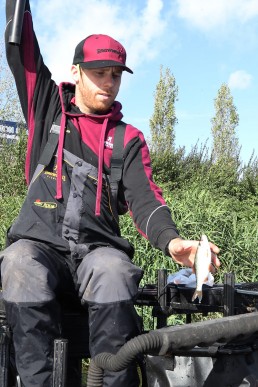
These hooks have a nice wire gauge, but are very strong.
"My choice for maggot and caster fishing."
Chopped Worm for Big Perch
First Published in English.
It’s all down to location
The most important part in catching a big bag of perch from any venue is simply down to location and a couple of winters back, during a match, I drew one off the flyer, an end peg on one of my club stretches on the Kennet and Avon Canal near Hungerford. Ever since watching the lucky angler that drew this peg who proceeded to take over 30lb of big perch I’ve been meaning to return, well today is the day!
The early bird…
If you want to get the best swim then you have to arrive early, set the alarm well before dawn, park up in darkness and start setting up as the sun rises. Fortunately today I’ve been blessed with a respite in the recent wet weather but looking at that sky, I’m on limited time before the rains arrive, the only downside is most of the swim is covered with leaves.
Canal craft
First job is to get the box set up nice and stable in the marginal vegetation, mix a little groundbait, plumb up a few areas and get some bait in to activate each line. I’ve settled on three lines, one at 8m where I’ve cupped in a couple of balls of groundbait made from a 50/50 mix of Champion’s Method Black Roach and Quick Skimmer which I pushed through a fine riddle a couple of times. My second line, slightly to my left at 11m, just on the downside of the far bank shelf and close to a line of rushes is prepped with a couple of cupfuls of chopped worm and casters and my final line at 13m is right across on top of the shelf just under the cover of the far bank overhanging bushes.
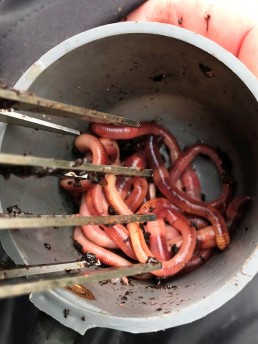
Roughly chop your worms for big fish.
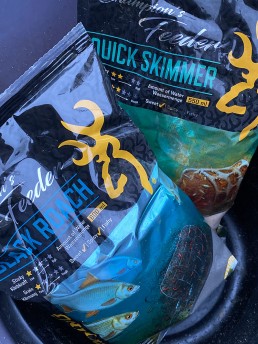
A great canal combination.
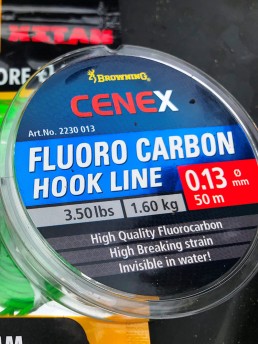
Fluoro Carbon, almost invisible in the water.
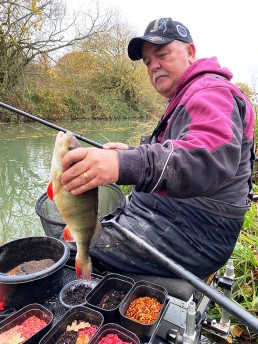
You don’t need many of these to build a good weight.
"The early bird catches the perch."
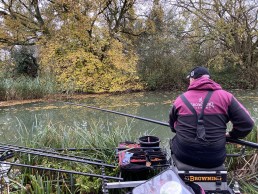
Start off with two cupfuls of bait.
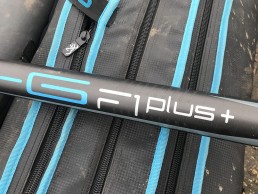
To my mind, the best pole on the market.
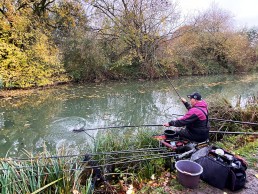
These big perch certainly give you the run around.
It’s not rocket science
As for tackle I’m using my trusted Sphere Zero-G F1+ Pole and although each line is slightly different regarding elastication and end rig, the one that is producing after rotating each line is the chopped worm and caster one. The rig for this is relatively simple and consists of Stretch 7 Blue 1.90mm Hollow Elastic, 0.12mm Cenex Hybrid Power line containing a 4×14 pole float, with a four inch Cenex 0.13mm Fluoro Carbon Hook Line and a Sphere size 16 Match Hook. Nothing fancy regarding shotting, just a bulk of no8 12’from the hook and a couple of tiny droppers spaced equally to the hook with the whole rig fished an inch over depth.
Reasons for
A couple of things worth pointing out is although I’m using a hook length that is of a wider diameter that the mainline, its breaking point is slightly less, the reason for the wider hooklink is its created from Fluoro Carbon, a material that fish find almost impossible to see, something when fishing for sight feeders such as perch is very important. I’ve also set up my pole roller down the edge so I can side ship my pole in and out without upsetting other canal tow path users and the Black Magic Double Width 60 Roller with its extendable legs allow just that!
Little reason to switch
A quick look at the 8m line from the off and its only producing small roach, which is a great sign as where there’s small fish there will be big perch and after fifteen minutes its time to lower half a Dendrobaena in on the 11m line and straight away the float sinks and I’m onto a reasonable perch. The action continues throughout the morning with perch to 2lb 6oz gracing my net and apart from one bite on the lobworm line I see very little reason to switch. It’s a good idea to keep pulting a few casters over the top to keep the small fish interested and every time bites dry up I simply introduce another cupful of chopped worm and casters which livens things up. After three hours and with the first spots of rain in the air I’ve had my fill and have ended up with at least 15lb of quality perch including a couple more around the two pound mark. Canal fishing, I love it.
Colin Sheppard

Side shipping is recommended on canals.

A plummet and a delicate but long tip float, both essential items of kit.

Sphere Match hooks, razor sharp, perfect when perch fishing.
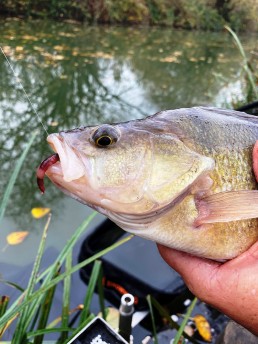
They just can’t resist the worm.
Colin’s Tackle
Sphere Zero-G F1+ Pole
Stretch 7 1.90mm Blue Elastic
4×14 pole float
0.12mm Cenex Hybrid Power Mono
0.13mm Cenex Fluoro Carbon Hook Line
Sphere Size 16 Match Hook
Colin’s Bait
Dendrobaena Worms
Lobworms
Casters
Squat
Maggot
Champion’s Feeder Black Roach & Quick Skimmer Groundbait.
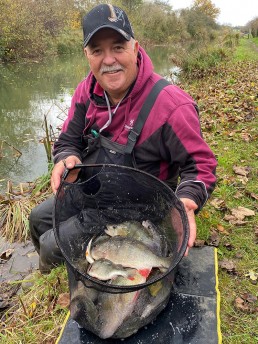
A brilliant mornings sport.
Xenos Wire Specialist Feeder
First Published in English.
If you spend much time feeder fishing on running water, particularly on big powerful rivers, such as the Trent, Wye or Severn, then you will know that feeder choice is absolutely critical. The Browning wire feeder has been the choice of a great many anglers over the years, thanks to their resilience and wide range of weights, making them useable without the addition of ‘dead cow’ weights. Well, now the range has been updated and the new Xenos wire feeders set a new benchmark in river feeders for me.
What I really like about the design of these feeders, is that they are very tangle-resistant, thanks to the integral lead and pre-formed attachment. These new feeders also have a tough plastic coating on the wire, that not only helps them blend in underwater, but also makes them even less likely to tangle. Attach them simply using a snap swivel or a short powergum boom to your main line
A wire cage feeder is really handy when the tackiness of what you’re feeding can vary. This particularly applies to chopped worms which can either make you groundbait mix very wet depending on how much you add. A wire feeder allows water to flow freely through it and while more enclosed plastic feeders might become clogged a wire feeder is still effective – this means you can easily adjust what you feeding without changing your feeder.
A useful tip when fishing deeper rivers, where you want the contents of the feeder to remain inside until the feeder settles on the bottom, is to wrap them in electrical tape, sealing up the mesh. This makes a massive difference to how the feeder empties and ensures that the bait is on the deck and not being washed downstream, taking the fish with it.
As with the originals, these are really tough feeders that take a lot of abuse. If you fish big rivers then they will be the perfect choice.
Available in 30mm and 50mm lengths with diameters of 2.5cm and 5cm respectively, they come in a wide range of weights from 20 grams (3/4 ounce) right up to 140 grams (5oz).
Kye Jerrom

The feeders come in a wide range of different weights for every situation.

The design is very tangle-resistant.

The simple set-up I use with the lighter versions of this feeder.
"The moulded-in lead is very tangle-resistant."
Winter 'Edges'
Original article published in English.
Winter fishing is normally associated with targeting the deeper water on commercial venues or fishing the long pole to features. However, I’ve enjoyed a lot of success fishing the edges here at Colemans Cottage, even on the coldest of days. It seems like the fish hug the near slope and you can often catch here when you can’t get a bite elsewhere. There are a few key differences to summer edge fishing which make all the difference.
Depth
The first thing I’m looking for with my edge fishing is depth. This varies depending on the temperature, water clarity and how active I expect the fish to be but around 3-feet (one metre) seems to be a good starting point. Generally, this will be found on a nice gradual slope so you can really pick and choose your depth by moving up or down the slope. As with any pole fishing, plumbing up accurately is essential to present your bait correctly on the slope without it hanging off bottom or laying on excessively. I like to just slightly lay on to make the bait sit naturally. If I’m foul hooking fish then I will look to move up the slope, if I don’t get any indications then I may look to move further down – a few inches either way can make a big difference.
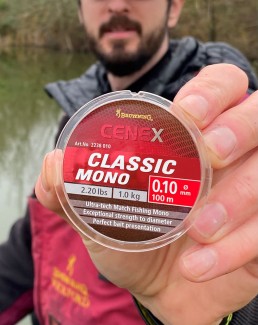
Cenex Classic Mono is my choice for hook lengths.

Xitan Stretch 7 Yellow is ideal for the plodding fights of winter carp.
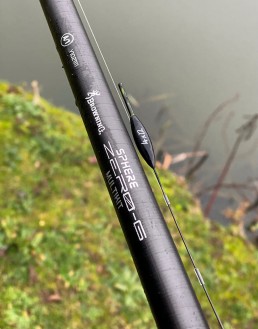
I use a dink float for margin fishing.
Bait choice
My approach centres on groundbait and live maggots. This may seem unusual in 3-feet of water, but because the fish are less active in winter foul hookers are much less of a problem. Groundbait offers just enough attraction to get me a bite, but washes away and doesn’t overfeed the peg. I normally feed it loose and very cautiously through a pole mounted pot, but sometimes a handful of crumb in a big pot can spark life into a peg which it appears devoid of fish. I very rarely feed maggots which means I get a faster bite as the fish snatch at the only food particle in the peg. In milder weather I will use the Formula Fish groundbait, but in the depths of winter this changes to a pure crushed expander mix with minimal food content. The groundbait itself must be as damp as possible and pushed through a riddle so that it settles quickly on the slope and doesn’t waft up easily.
Tackle
Rig wise, I normally use a 4 x 12 carp dink with the float dotted right down. I may step up a size if the wind is affecting the presentation. This is tied to 0.16mm Cenex Hybrid Power mainline and a 4-inch 0.10mm or 0.12mm Cenex Hybrid Power hooklength to an 18 or 20 hook depending on how hard I expect the fishing to be. Elastic wise, the yellow Xitan Stretch 7 is perfect; soft enough for the fish to glide out of the swim, but with enough power to land double-figure fish. Shotting would be a bulk or strung bulk of no.9s, again depending how active the fish are. I use a fairly long line to my float and use back shot to control the rig to avoid spooking fish in the clear water.

Formula Fish attracts without feeding.

Big carp can still be caught down the edge in winter on many venues.
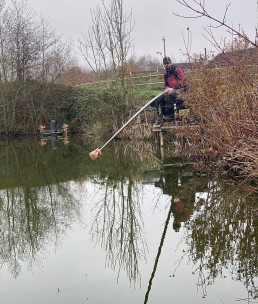
Often, I will feed groundbait with no feed, and then use a maggot hookbait over the top.
"Always leave yourself somewhere to go when the fish back off."
Tips
Another key difference from summer time is the fish will back-off from one spot very quickly. Changing depth or re-plumbing a new line where the fish feel safe will often get a crucial few extra bites. For this reason I always leave myself somewhere to go and never fish to the limit of my peg early on. I find about half-way to the next platform to be a good starting point, but it is always dependant on depth more than anything. One of the most important things is to never give up! You might not get a bite down the edge until late in the match but you can then put together a winning catch in no time. Hopefully this helps give you the confidence to fish your edges through the winter, you might be surprised at the results!
Alex Reynolds
Xenos Wire Pro Cast Feeder
Original article published in English.
I was a firm fan of the original Xenos feeders and these new versions are even better! The new plasticised coating gives the wire a nice low-key colour that blends in well and makes the feeders smooth to the touch, which I suspect may reduce the chances of tangles.
Of the Xenos range my favourite is the Pro Cast feeder. With the weight strategically positioned below the cage these feeders cast like bullets. If you are looking for more range, without compromising accuracy, then give these a go.
I find them ideal for bream fishing where I want to introduce a reasonable amount of bait. The size is just right. They come in a range of weights, with the 30gram being ideal for medium range fishing, and the heavier sizes being great when maximum range is essential.
The Looped attachment is simple but effective. I normally use a clip swivel attached to a short boom either running on the main line or fished ‘helicopter-style’
One useful tip with any cage feeder is to carry some electrical tape with you, or add a wrap of shrink tube at home around the cage. This stops any of the bait escaping through the gaps in the mesh on the drop, ensuring your patch of bait is as tight as possible on the bottom. A useful ploy when the fishing is tough.
If you are looking for a mesh feeder that will cast accurately and to maximum range then be sure to have a look at the Pro Cast.
Length 30mm by 25mm long
Weights between 30 grams and 70 grams
Pat Cuddy
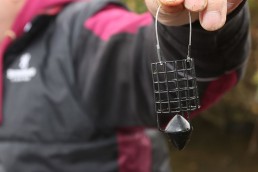
The central weight means this feeder casts really accurately and is perfect for long range fishing.
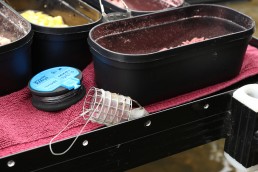
The range of weights are perfect for Stillwater fishing.
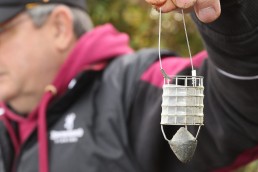
Use shrink tube or tape to slow the release of bait.
"I find them ideal for bream fishing "
Feeder Connector Swivel
Original article published in English.
These little gems have become an integral part of most of my feeder rigs and even some float set-ups. Like many of the best ideas, they are incredibly simple, yet very effective, and most importantly, tangle-free.
These are extremely strong mini-swivels, but instead of having two eyes, one of the wires has been formed into a parallel hook-shape. A small piece of hard-wearing rubber tube fits over the hook effectively closing the loop when in use.
So what you have is a very simple method of changing your hooklenghs instantly. Couple this with the anti-twist properties of the swivel, and the tangle-resistant design and you have a brilliant connector that is ideal for a multitude of feeder rigs.
A little tip shown to me by England International Will Freeman was to use two stots instead of beads between the Connector Swivel and the feeder link. This creates a tiny boom that holds the hooklength away from the boom, massively cutting down on tangles. Give it a go, combined with these connector swivels it is a great little edge.
Available in 10mm and 12mm sizes.
Kye Jerrom
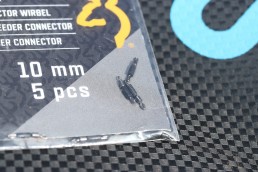
These tiny swivels make changing links very easy.

Simply slide the rubber back to change hook lengths.

I use this very simple feeder set-up.
